This perennial herb with a vigorous rhizome, a strong stem from 30 to 90 cm high, linear leaves, smooth with sharp edges, with a silvery plume, is widespread throughout tropical Asia. A species that has surely been introduced but has become spontaneous, it forms savannahs on degraded and cleared forests and is now a constituent element of the landscape of northern Laos. Farmers and garden lovers complain about it because it is very invasive and difficult to uproot, fortunately, it is also useful.
In the young state, the leaves constitute an estimated and abundant fodder since the plant invests in itself the deforested spaces.
In the adult state, these leaves are used to cover houses. The strawberry grass is harvested at the beginning of the dry season when the roofs are rebuilt. It is the woman who harvests the plant, sometimes quite far from the family home; she dries it on the spot for 5 days and then brings it back home. She then makes tiles of about one meter long and half a meter wide at a rate of about twenty tiles per day; it will take between 300 and 400 to cover a house. The installation of bamboo supports is collective, it is generally done in March or April. This roof will last about 3 years.
The strawberry grass gives a good paper pulp which can replace the one provided by the mulberry trees in case of need and that is all the more as the two plants often occupy the same territories. Moreover, the inflorescences are sometimes used as cotton.
In traditional medicine the strawberry herb is mainly used for skin diseases; the rhizomes are commonly sold on the markets to make baths for children suffering from scabies and various pimples; the inflorescences are said to have healing power. With the rhizomes, one also makes decoctions which would be diuretic and depurative, good thus for the skin but also for venereal diseases.
Finally, this herb would have the power to repel evil spirits and it is good to hang a piece on the front door of the house.
Cette herbe vivace à rhizome vigoureux, à tige forte de 30 à 90 cm de haut, aux feuilles linéaires, lisses à bords coupants, au panache argenté, est très répandue dans toute l’Asie tropicale. Espèce sûrement introduite mais devenue spontanée, elle forme des savanes sur les forêts dégradées et défrichées et constitue désormais un élément constitutif du paysage du Nord Laos. Les agriculteurs et les amoureux de leur jardin s’en plaignent car elle est très envahissante et difficile à arracher, fort heureusement elle est aussi utile.
A l’état jeune les feuilles constituent un fourrage estimé et abondant puisque la plante investit d’elle-même les espaces déboisés.
A l’état adulte ces feuilles sont employées à la couverture des maisons. L’herbe à paillote est récoltée au début de la saison sèche lorsque l’on refait les toits. C’est la femme qui récolte la plante parfois assez loin de l’habitation familiale; elle la fait sécher sur place pendant 5 jours puis la ramène à la maison. Elle confectionne ensuite des tuiles d’environ un mètre de long et un demi de large à raison d’une vingtaine de tuiles par jour; il en faudra entre 300 et 400 pour couvrir une maison. La pose sur des supports en bambou est collective, elle se fait en général au mois de mars ou avril. Ce toit durera environ 3 ans.
L’herbe à paillote donne une bonne pâte à papier qui peut remplacer celle fournit par les mûriers en cas de besoin et cela d’autant mieux que les deux plantes occupent souvent les mêmes territoires. En outre, les inflorescences sont parfois utilisées comme du coton.
En médecine traditionnelle l’herbe à paillote est surtout utilisée pour les maladies de peau; les rhizomes sont couramment vendus sur les marchés pour faire des bains destinés aux enfants atteints de gale et de divers boutons; les inflorescences auraient un pouvoir cicatrisant. Avec les rhizomes on fait également des décoctions qui seraient diurétiques et dépuratives, bonnes donc pour la peau mais aussi pour les maladies vénériennes.
Enfin, cette herbe aurait le pouvoir de repousser les mauvais esprits et il est bon d’en accrocher un morceau sur la porte d’entrée de la maison.
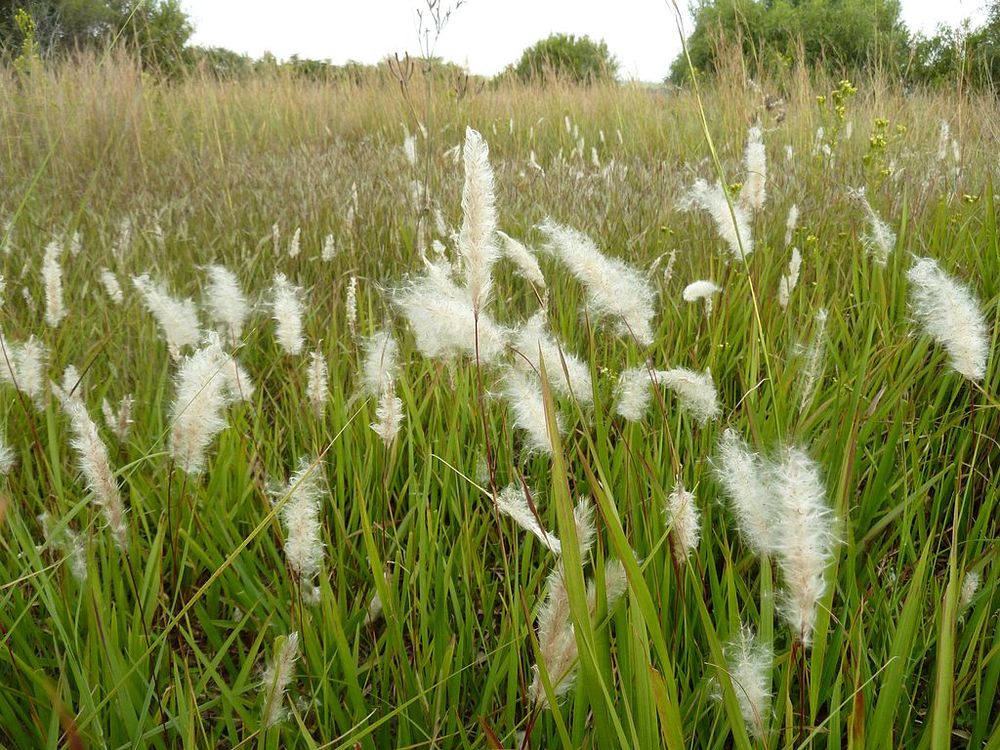
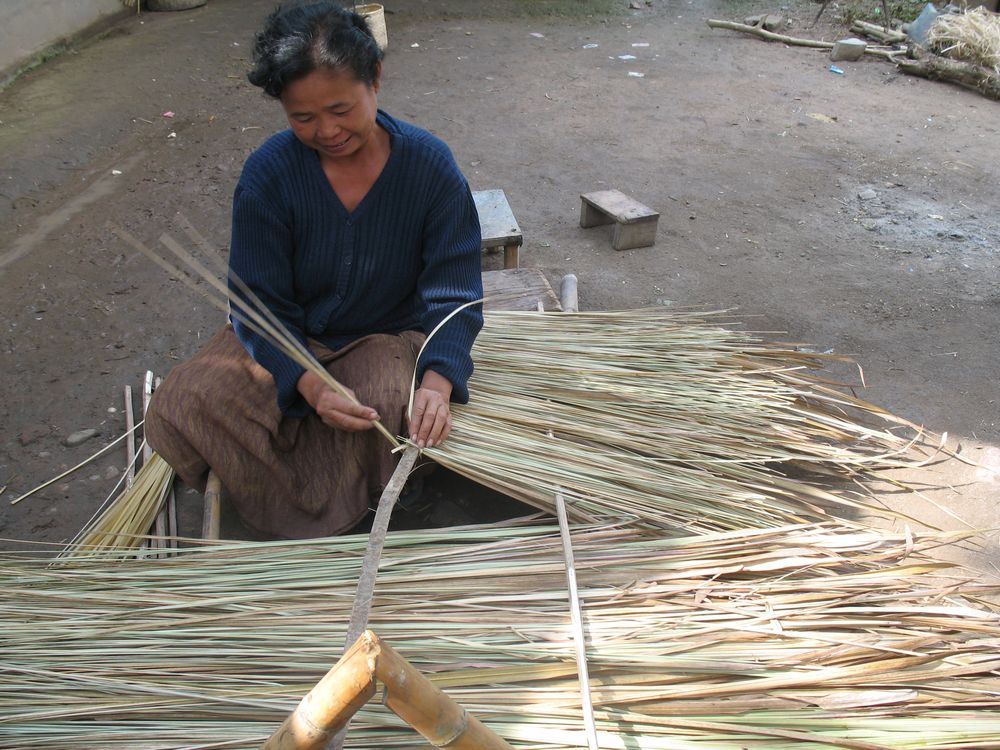
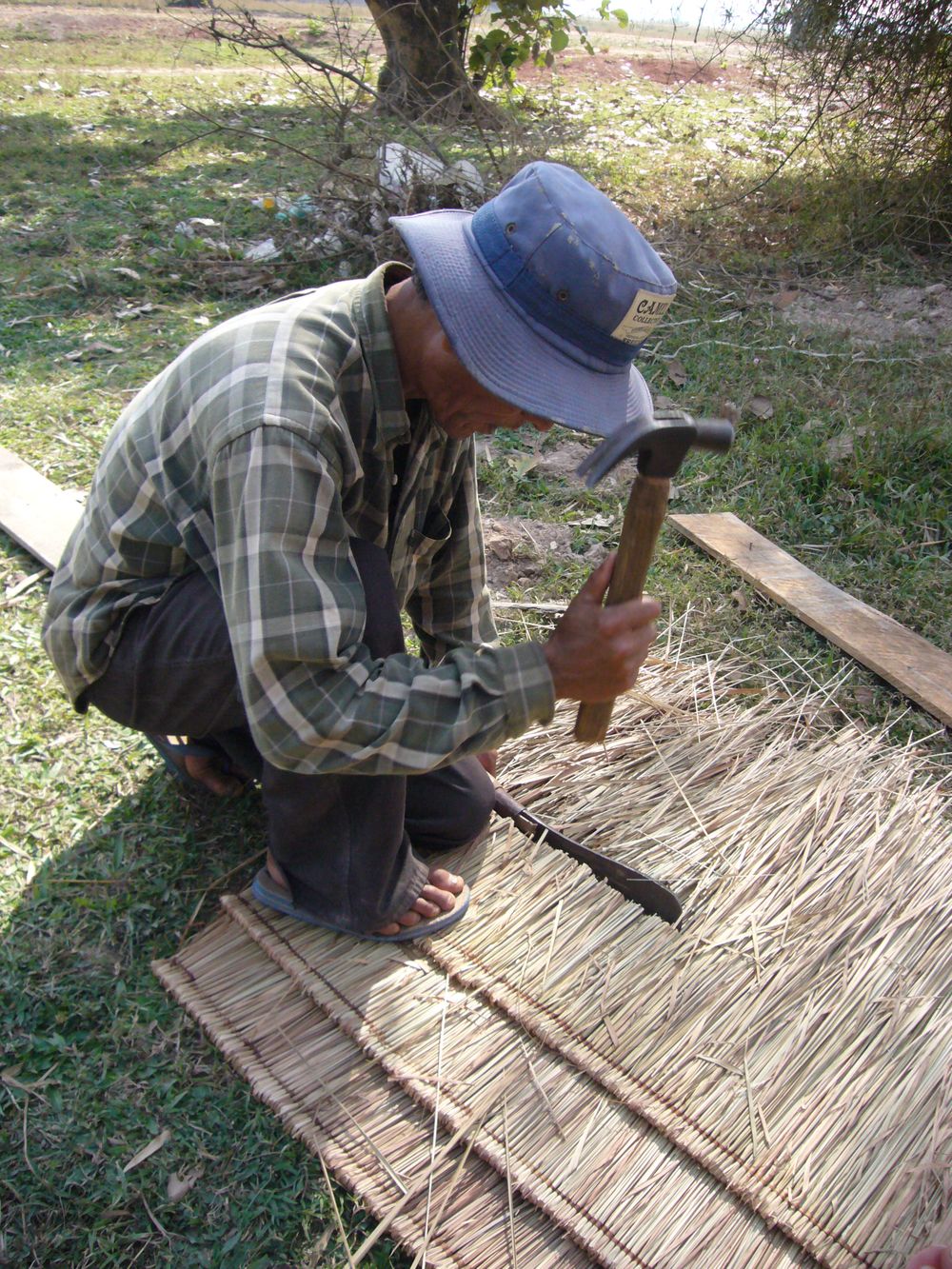
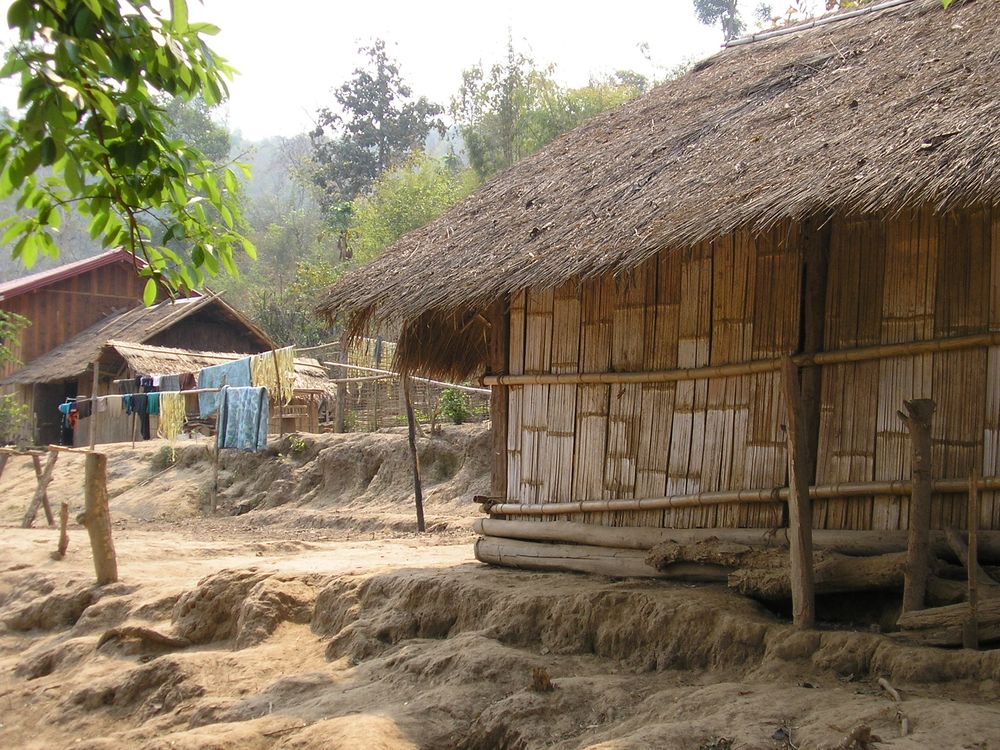
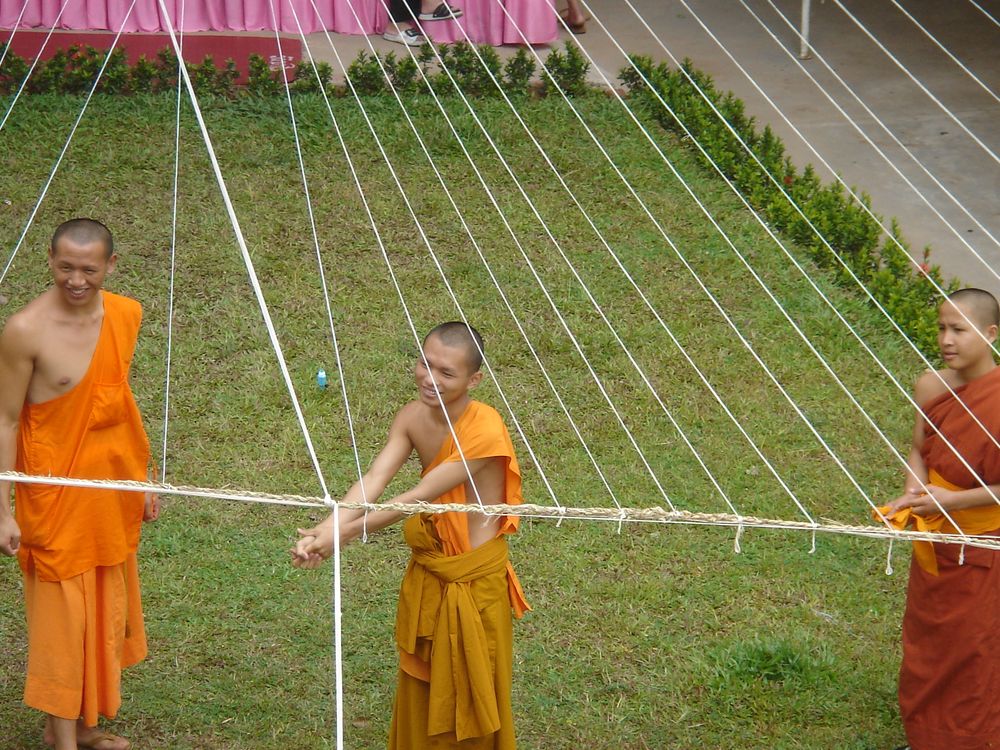
This perennial herb with a vigorous rhizome, a strong stem from 30 to 90 cm high, linear leaves, smooth with sharp edges, with a silvery plume, is widespread throughout tropical Asia. A species that has surely been introduced but has become spontaneous, it forms savannahs on degraded and cleared forests and is now a constituent element of the landscape of northern Laos. Farmers and garden lovers complain about it because it is very invasive and difficult to uproot, fortunately, it is also useful.
In the young state, the leaves constitute an estimated and abundant fodder since the plant invests in itself the deforested spaces.
In the adult state, these leaves are used to cover houses. The strawberry grass is harvested at the beginning of the dry season when the roofs are rebuilt. It is the woman who harvests the plant, sometimes quite far from the family home; she dries it on the spot for 5 days and then brings it back home. She then makes tiles of about one meter long and half a meter wide at a rate of about twenty tiles per day; it will take between 300 and 400 to cover a house. The installation of bamboo supports is collective, it is generally done in March or April. This roof will last about 3 years.
The strawberry grass gives a good paper pulp which can replace the one provided by the mulberry trees in case of need and that is all the more as the two plants often occupy the same territories. Moreover, the inflorescences are sometimes used as cotton.
In traditional medicine the strawberry herb is mainly used for skin diseases; the rhizomes are commonly sold on the markets to make baths for children suffering from scabies and various pimples; the inflorescences are said to have healing power. With the rhizomes, one also makes decoctions which would be diuretic and depurative, good thus for the skin but also for venereal diseases.
Finally, this herb would have the power to repel evil spirits and it is good to hang a piece on the front door of the house.
Cette herbe vivace à rhizome vigoureux, à tige forte de 30 à 90 cm de haut, aux feuilles linéaires, lisses à bords coupants, au panache argenté, est très répandue dans toute l’Asie tropicale. Espèce sûrement introduite mais devenue spontanée, elle forme des savanes sur les forêts dégradées et défrichées et constitue désormais un élément constitutif du paysage du Nord Laos. Les agriculteurs et les amoureux de leur jardin s’en plaignent car elle est très envahissante et difficile à arracher, fort heureusement elle est aussi utile.
A l’état jeune les feuilles constituent un fourrage estimé et abondant puisque la plante investit d’elle-même les espaces déboisés.
A l’état adulte ces feuilles sont employées à la couverture des maisons. L’herbe à paillote est récoltée au début de la saison sèche lorsque l’on refait les toits. C’est la femme qui récolte la plante parfois assez loin de l’habitation familiale; elle la fait sécher sur place pendant 5 jours puis la ramène à la maison. Elle confectionne ensuite des tuiles d’environ un mètre de long et un demi de large à raison d’une vingtaine de tuiles par jour; il en faudra entre 300 et 400 pour couvrir une maison. La pose sur des supports en bambou est collective, elle se fait en général au mois de mars ou avril. Ce toit durera environ 3 ans.
L’herbe à paillote donne une bonne pâte à papier qui peut remplacer celle fournit par les mûriers en cas de besoin et cela d’autant mieux que les deux plantes occupent souvent les mêmes territoires. En outre, les inflorescences sont parfois utilisées comme du coton.
En médecine traditionnelle l’herbe à paillote est surtout utilisée pour les maladies de peau; les rhizomes sont couramment vendus sur les marchés pour faire des bains destinés aux enfants atteints de gale et de divers boutons; les inflorescences auraient un pouvoir cicatrisant. Avec les rhizomes on fait également des décoctions qui seraient diurétiques et dépuratives, bonnes donc pour la peau mais aussi pour les maladies vénériennes.
Enfin, cette herbe aurait le pouvoir de repousser les mauvais esprits et il est bon d’en accrocher un morceau sur la porte d’entrée de la maison.










This perennial herb with a vigorous rhizome, a strong stem from 30 to 90 cm high, linear leaves, smooth with sharp edges, with a silvery plume, is widespread throughout tropical Asia. A species that has surely been introduced but has become spontaneous, it forms savannahs on degraded and cleared forests and is now a constituent element of the landscape of northern Laos. Farmers and garden lovers complain about it because it is very invasive and difficult to uproot, fortunately, it is also useful.
In the young state, the leaves constitute an estimated and abundant fodder since the plant invests in itself the deforested spaces.
In the adult state, these leaves are used to cover houses. The strawberry grass is harvested at the beginning of the dry season when the roofs are rebuilt. It is the woman who harvests the plant, sometimes quite far from the family home; she dries it on the spot for 5 days and then brings it back home. She then makes tiles of about one meter long and half a meter wide at a rate of about twenty tiles per day; it will take between 300 and 400 to cover a house. The installation of bamboo supports is collective, it is generally done in March or April. This roof will last about 3 years.
The strawberry grass gives a good paper pulp which can replace the one provided by the mulberry trees in case of need and that is all the more as the two plants often occupy the same territories. Moreover, the inflorescences are sometimes used as cotton.
In traditional medicine the strawberry herb is mainly used for skin diseases; the rhizomes are commonly sold on the markets to make baths for children suffering from scabies and various pimples; the inflorescences are said to have healing power. With the rhizomes, one also makes decoctions which would be diuretic and depurative, good thus for the skin but also for venereal diseases.
Finally, this herb would have the power to repel evil spirits and it is good to hang a piece on the front door of the house.
Cette herbe vivace à rhizome vigoureux, à tige forte de 30 à 90 cm de haut, aux feuilles linéaires, lisses à bords coupants, au panache argenté, est très répandue dans toute l’Asie tropicale. Espèce sûrement introduite mais devenue spontanée, elle forme des savanes sur les forêts dégradées et défrichées et constitue désormais un élément constitutif du paysage du Nord Laos. Les agriculteurs et les amoureux de leur jardin s’en plaignent car elle est très envahissante et difficile à arracher, fort heureusement elle est aussi utile.
A l’état jeune les feuilles constituent un fourrage estimé et abondant puisque la plante investit d’elle-même les espaces déboisés.
A l’état adulte ces feuilles sont employées à la couverture des maisons. L’herbe à paillote est récoltée au début de la saison sèche lorsque l’on refait les toits. C’est la femme qui récolte la plante parfois assez loin de l’habitation familiale; elle la fait sécher sur place pendant 5 jours puis la ramène à la maison. Elle confectionne ensuite des tuiles d’environ un mètre de long et un demi de large à raison d’une vingtaine de tuiles par jour; il en faudra entre 300 et 400 pour couvrir une maison. La pose sur des supports en bambou est collective, elle se fait en général au mois de mars ou avril. Ce toit durera environ 3 ans.
L’herbe à paillote donne une bonne pâte à papier qui peut remplacer celle fournit par les mûriers en cas de besoin et cela d’autant mieux que les deux plantes occupent souvent les mêmes territoires. En outre, les inflorescences sont parfois utilisées comme du coton.
En médecine traditionnelle l’herbe à paillote est surtout utilisée pour les maladies de peau; les rhizomes sont couramment vendus sur les marchés pour faire des bains destinés aux enfants atteints de gale et de divers boutons; les inflorescences auraient un pouvoir cicatrisant. Avec les rhizomes on fait également des décoctions qui seraient diurétiques et dépuratives, bonnes donc pour la peau mais aussi pour les maladies vénériennes.
Enfin, cette herbe aurait le pouvoir de repousser les mauvais esprits et il est bon d’en accrocher un morceau sur la porte d’entrée de la maison.


